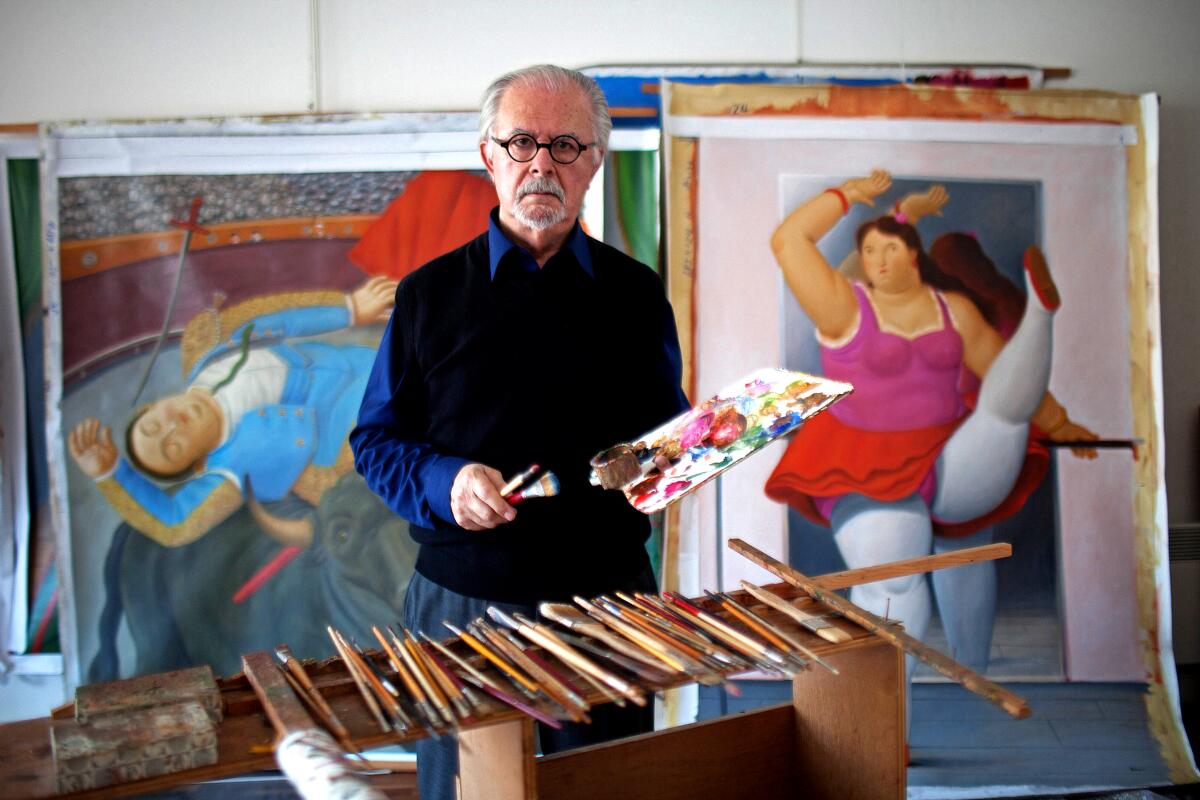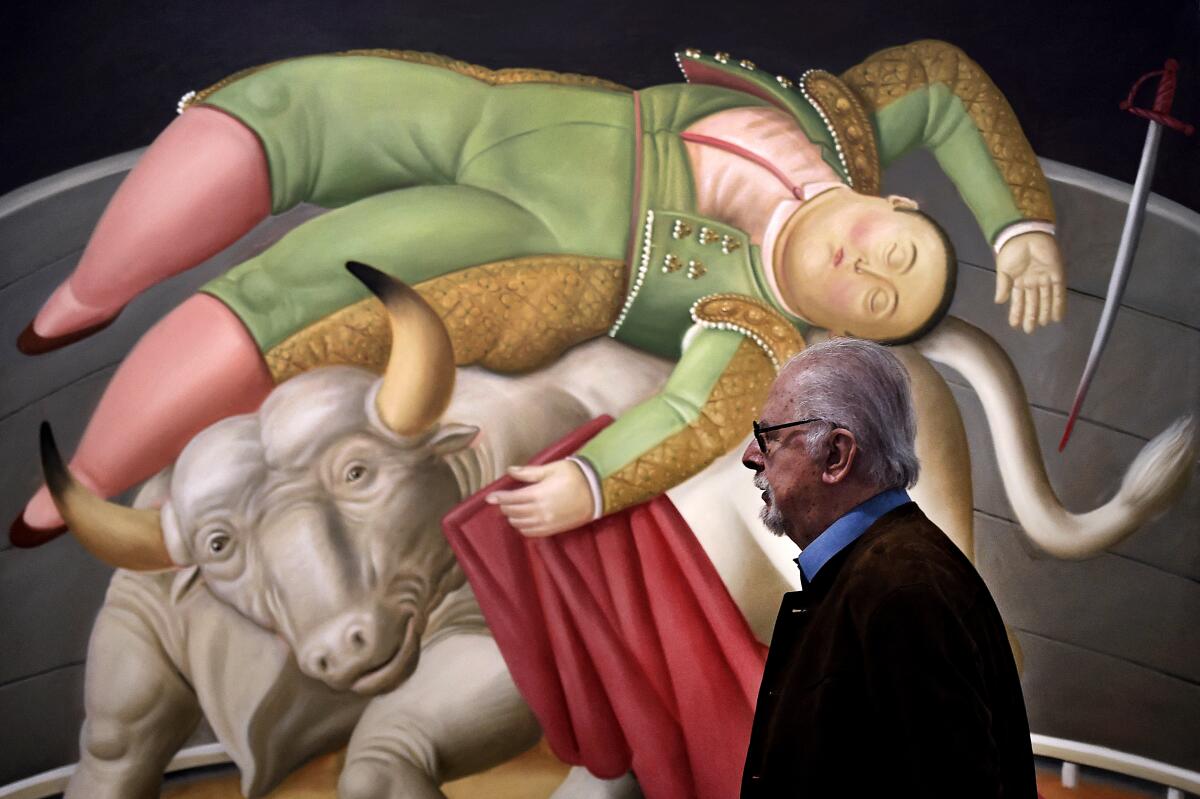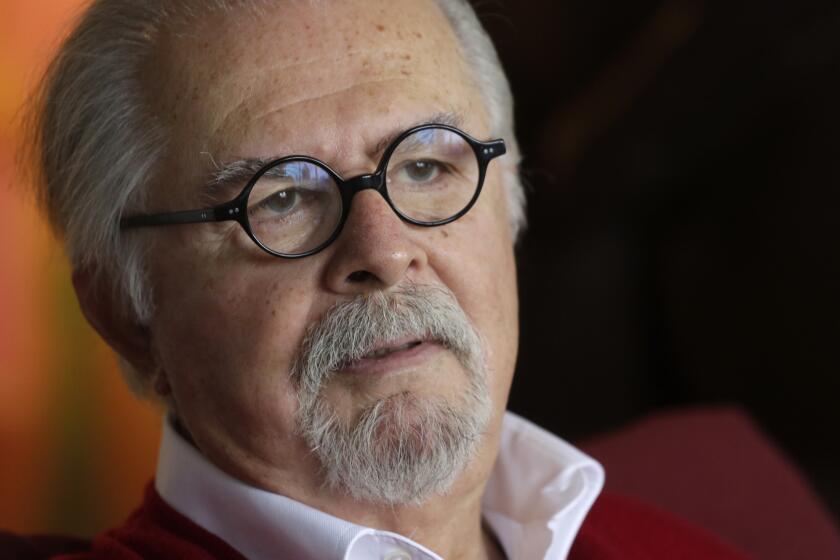Appreciation: Often spurned by the contemporary art world, Fernando Botero made meaningful art

- Share via
During my art school education at the School of the Art Institute of Chicago in the early ’90s, our teachers made us study the history of painting ranging from the old masters to the Abstract Expressionists. We learned about various approaches to shape, texture, brushstroke and color. We memorized all of Guston’s and De Kooning’s paintings and looked at Baselitz, Tàpies, Richter and Kiefer. Professors also taught us to appreciate the compositions of Latin American artists like Wilfredo Lam and Roberto Matta’s mesmerizing merging of abstraction and surrealism. But I don’t recall a single instance where any of our painting professors asked us to look at the work of Fernando Botero.
It is not that we didn’t know of Botero’s work. For decades, his work has been ubiquitous. As the first Colombian artist to attain worldwide recognition, Botero, who died last week at the age of 91, is among a rarefied group of 20th century artists whose imagery is immediately recognizable. His work even generated the eponym “Boteroesque,” referring to enlarged figures like the ones he created.
And therein lies the conundrum with Botero: He was an artist largely spurned by the contemporary art world who nonetheless had a massive global visibility and commercial success.

This was not always so. Early in his career, in the 1960s, Botero’s work was acquired by curator Dorothy Miller at MoMA, who saw in him a painter that pursued figuration in a new way, someone who went against the grain of the then-reigning AbEx movement. Botero never pursued abstraction, preferring instead to depict inflated figures. Once he settled into that form of working he never wavered from it, sticking to it for the rest of his life.
Artists who operate this way are looked down upon by the art world’s intelligentsia. The expectation is for artists to evolve, to take new formal or conceptual approaches as times change. To stick to the same strategy regardless of the period is seen as too easy, formulaic and predictable, and mainly a strategy to appeal to the market (which Botero did, with astonishing success. His paintings and sculptures tend to fetch between $1 million and $5 million each). But the real problem that the art world has with Botero lies less in the homogeneity of his production and more in the animated quality of his paintings, a form of modern kitsch mannerism that makes the traditional, art-school-trained eye cringe. Out of all the things he was, he was not a painter’s painter. Had he been my classmate, my painting teachers would have probably flunked him.
But is our rejection of Botero indicative of our own elitism? As a lifelong artist and art educator I have to ask myself that question (and I can already hear the protests among my artist and curator friends). If you visit Colombia, you can appreciate Botero’s seismic cultural impact. I have never seen a living artist whose work has become part of the popular art of a country, to the point of creating a local identity, to the degree which Botero’s paintings occupy in Colombia.
When you walk down the tourist areas of Cartagena and his native Medellín you can see hundreds of openly fake Botero paintings for sale (a few years back I bought one in Cartagena for $10) — most of which are actual reproductions of the painter’s famous works. Botero allowed this practice, and in fact was flattered by it. A whole community of Botero imitators exists today, each of them bearing reputations of their own — to the point that these forgers sign the paintings with their own names, not Botero’s.
Because an artist is more than the sum of their parts, their legacy often needs to be appreciated beyond their physical works. Botero had a huge, positive impact on the arts of Colombia, becoming a generous donor and bequeathing his art collection (which included works by Picasso, Dalí, Beckmann and Degas) to two national museums. He was also not indifferent to social or political struggle. In 2007 he presented a series of paintings that denounced the inhuman treatment of Iraqi prisoners by American forces at Abu Ghraib prison near Baghdad. Albeit surprising, the series wasn’t altogether out of character given that, earlier in his career, Botero had produced paintings criticizing military dictatorships in Latin America.
Fernando Botero, whose depictions of people and objects in plump, exaggerated forms became emblems of Colombian art around the world, has died. He was 91.
Notwithstanding this politically engaged dimension of his work, many saw his approach as formulaic. “Botero is the purest example of how an instantly recognizable ‘style’ can defeat a gifted and wide-ranging artist,” curator Robert Storr tells me. “The pneumatic, inflatable appearance of almost everything in his work — from cats to girls to generalissimos, in paintings as well as in sculptures — is so consistent and inherently funny (and therefore satirically useful and effective when mocking bloated South American oligarchs) — that late in his career when he tried to apply a toned down version of it to the subject matter of political violence, perpetrated by that superficially risible ruling class, he made work that became oppressively cute, self-contradicting and impossible to take seriously. Thus his trademark became his downfall.”
Botero was fully aware of the ambivalence that his work inspired and he was content with it (although it should be said that being one of the wealthiest artists of his time it would be hard to complain). As for us, we are left now with the problem of how to assess his contributions.

Personally, I am not one for a stylistic brand approach in art. But I also recognize that the works that we deem historically important do not necessarily or always transform culture, as Botero’s paintings have in Colombia and beyond. Art-world criticisms aside, the undeniable fact remains that Botero’s rotund figures are here to stay — and will likely remain ingrained in our collective consciousness for generations as well as in museums, galleries, auction houses, and in the folk art of the streets of Medellín.
More to Read
The biggest entertainment stories
Get our big stories about Hollywood, film, television, music, arts, culture and more right in your inbox as soon as they publish.
You may occasionally receive promotional content from the Los Angeles Times.











